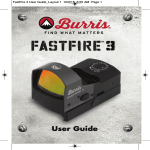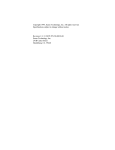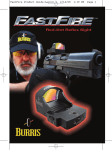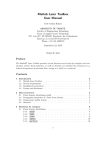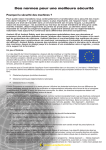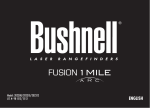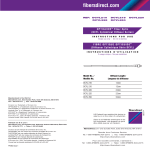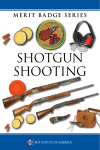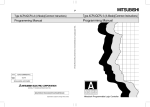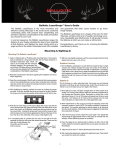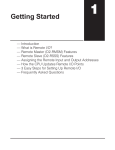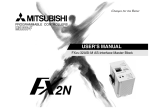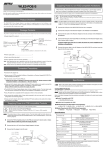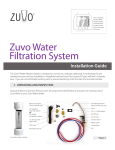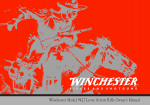Download Mounting & Sighting-In Eliminator™ LaserScope User`s Guide
Transcript
Eliminator™ LaserScope User’s Guide The Eliminator LaserScope is the most innovative and effective hunting riflescope in the world. Combining outstanding optics with pinpoint laser rangefinding and precision trajectory compensation with the exact ammunition you choose for your hunt, it eliminates most of the variables and guesswork that often cause hunters to go home empty-handed. In one fast sequence the Eliminator determines the distance to your target, factors in your trajectory and illuminates the perfect holdover. It’s that simple. The Eliminator significantly extends the range and accuracy of virtually any gun and any load. It is the perfect optic for centerfire and rimfire rifles, muzzleloaders and slug guns. No other riflescope combines this level of quality, technology, accuracy, repeatability and effectiveness. It will greatly increase the distance at which you can make an ethical shot. Congratulations and thank you for choosing the Eliminator LaserScope by Burris. Mounting & Sighting-In Mounting The Eliminator LaserScope ™ 1. Select a Weaver-style or Picatinny-style mounting base. If a two-piece base is selected for a long action bolt rifle, the front base should be a reversible (extension) base which will need to be mounted with the extension directed rearward. We recommend the use of Burris XTB Bases (Xtreme Tactical Bases) as they were also designed with the special mounting considerations of the Eliminator LaserScope. 2. Read the manufacturer’s directions regarding the installation of mounts before beginning. 3. Clean the mounting area of the rifle with a chemical that removes grease and oil. Pay special attention to screw holes. Using the same chemical, clean the mounts. Do not allow the cleaning chemical to come in contact with the stock or scope lenses. 4. After installing the base(s), position the scope so it offers the proper eye relief. To do this, shoulder the rifle as you would in the field. Position the scope as far forward as possible while achieving a full field of view. LaserScopeTM Rail (rear) Rear Mount Base 5. Note the two base slots you will use to attach the scope, and with the mount clamps open fully, place the Mount Bolts into those slots on the base. Now match up the Eliminator scope slots and place over the two mount bolts - rocking the scope side to side until the scope is flush with the base and mount clamps gripping from the lip of the base to the lip of the rail on the underside of the scope. Finger tighten only. 6. In completing step #5, position the hex nuts on the side of the rifle opposite the side you will mount the remote transmitter. There must be clear line of sight between the transmitter and the remote Mount control receiver. Mount Bolt Clamp 7. With hex nuts slightly loosened, push the scope forward and then firmly tighten both hex nuts to 50 to 70 inch/pounds. Eyepiece Focusing 1. Aim the Eliminator LaserScope in a safe direction toward the sky or a light colored wall. Glance through the scope and notice if the reticle is sharply focused. Most users will find that no adjustment is necessary. If the reticle is not in sharp focus, rotate the eyepiece focus ring until the reticle appears in sharp focus. Double check your focus by taking quick glances through the scope and make any fine tuning adjustments as necessary. Sighting In Do all shooting in a safe, authorized area. Use proper eye and hearing protection and follow all safe shooting rules. Select the ammunition you intend to use in the field and use it to sight in the firearm. 1. Bore sight your scope, OR place a target about two feet square at 25 yards. Fire a shot at the bullseye. Make the necessary adjustments to the Windage and Elevation knobs. Remember, a scope with a click adjustment value of 1/4 inch at 100 yards will require four clicks to move the same 1/4 inch distance at 25 yards. Burris scopes have the click value indicated on a label under one of the adjustment caps. 2. Make adjustments on the scope by turning the adjusting screws the necessary number of clicks. NOTE: The reticle (crosshair) is centered at the factory. This permits adjusting the reticle equally in all directions from the center position. Three shot groups are suggested to determine the actual point of impact. 3. After the first group is fired, adjust the scope again. This adjustment should bring the approximate center of the group to coincide with the bullseye. Shoot additional groups as necessary. 4. Place the target at recommended sight-in distance of 50, 100 or 200 yards. Refer to the Cartridge List to determine the proper range(s) for your load or cartridge. Make the necessary adjustments so your group coincides with the bullseye. 5. Align the dial to read “0” without allowing the silver knob to turn. Hex Nut 6. After making the adjustments, replace the adjustment caps. They protect your scope from dust and moisture. 1 ELIMINATOR™ LASERSCOPE OPERATION Elevation Adjustment Elevation Adjustment Eyepiece Focus Ring Windage Adjustment Battery Cover Windage Adjustment Main Switch Setup Button (detail below) 1. Battery Installation or Replacement The range displayed is the horizontal distance to the target. The Eliminator LaserScope has a built-in angle sensor and it converts the actual distance to horizontal distance. The horizontal distance is mostly what affects a bullet’s trajectory so no matter what the uphill or downhill angle, the Eliminator automatically converts the distance to use for determining the aiming point. Unload the gun. Use a coin or screwdriver to unscrew the battery cap screw on the top, rear of the scope, just in front of the eye piece. Install a lithium CR2 battery. Reinstall the battery cover. NOTE: A sticker on the underside of the battery contains basic set-up instructions. Battery Cover If the scope fails to get an accurate range reading, it will display a line of three flashing bars. CR2 Battery 5. Set Up the Eliminator For Your Specific Cartridge First decision - What Units do you want to work in, Yards or Meters? Y/M 2. LaserScope Battery Life: Second decision - Do you want or need to zero at 50, 100 or 200 Yards / Meters? Battery life is nominally rated at 5000 cycles. This will vary depending on the quality of the battery and the temperatures at which the unit is operated. Batteries lose a good deal of their power potential in colder temperatures. Battery: Full Battery: Half Carry a spare Info Needed - For long-range cartridges: the drop in inches at 500 yards if you zero at 100. For intermediate range loads, you’ll need the drop in inches at 200 yards if you zero at 50 yards. This figure will be your Drop Number. Battery: Low Replace the battery 3. Start the electronics Press the main switch button on the left side of the scope, just behind the Burris logo. Look through the scope. It should show two things: the yards(Y) or meters(M) indication illuminated along with the battery status indicator. The indicators will stay on for 8 seconds. 4. Electronic Basics Start the electronics and aim at a target. Press either the left side button again or the Remote Activation Switch. The scope will display the horizontal range to your target at the top and also display an illuminated dot on the crosshair. 2 3. With the currently selected table displayed you have 30 seconds to click the Forward Arrow button to enter the Cartridge List Set-up mode. The “T” (for Table Select) is lit steady; the Unit (Y or M) is flashing when you enter M Table Select mode. Press the Up Arrow Select or Change Meters to select Y (yards) or the Down Arrow to select M (meters). When you have the measurement unit you want flashing, press and release the Forward Arrow button to load your choice. Select or Change Yards There are several ways to determine your Drop Number: 1. For factory loads, the Cartridge List that came with your scope will show the drop number for most of the currently available factory ammo. 2. Factory ammo web sites sometimes provide this information. 3. The drop number may appear on the ammo box. 4. Ballistics Software Programs. 5. Measure your actual bullet drop at 200 or 500 yards, when sighted in at 50 or 100 yards, as needed. 6. Use the Cartridge List to estimate your drop number by finding similar loads or cartridges with the same muzzle velocity and BC number. 7. Burris website-www.burrisoptics.com. 4. The “T” is still on steady, your (Y or M) is on and steady, your first numeric digit is flashing, and the other two are now out. Enter your selected Zero Distance: 0 = 50 Yards/Meters; 1 = 100 Yards/Meters; or 2 = 200 Yards/Meters. Press the Up Arrow to increase the number or the Down Arrow to decrease it. When your selected sight-in distance is displayed Set Zero Distance (1 or 2) (flashing), press and release the Forward Arrow button. Note: the actual correct drop number will be affected by your gun and shooting altitude unless you actually measure your drop. All other methods provide approximate numbers, typically correct ±3 inches at 500Y. No matter what units you chose to work in (yards or meters) or distance you intend to Zero at, the Cartridge Lists are selected based on drop at either 200 Yards when zeroed at 50 Yards (for intermediate range cartridges) or 500 Yards when zeroed at 100 Yards (for modern long- range cartridges). 5. The last two numbers (Drop Number from the Cartridge List ) should be flash- Complete the Ballistic Table with your Drop Number ing. Press the Up Arrow to increase the number, or the Down Arrow to decrease it. When the Drop Number you want is displayed (flashing), press and release the Back Arrow button to exit the Set-up mode. Your 3-digit Cartridge List will begin with a “0” if you need to sight-in at 50 Yards/Meters, a “1” for 100 Yards/Meters sight in, or a “2” if you intend to sight-in at 200 Yards/Meters. This number is followed by your Drop Number which will vary between 5 and 90. (See the Cartridge List to determine what zero ranges and drop numbers are available and appropriate for your cartridge.) 6. You are ready to go shooting. Re-zero the gun if necessary at your selected sight-in distance. For optimum accuracy, verify point of impact by actual shooting. Depending on the exact ammo performance, your gun’s barrel length, the elevation, and any extreme temperatures, you might need to increase or decrease your Drop number by a couple of digits for exacting performance. There are four arrows on the Setup button on the right side of the scope. These are used only for programming. They have no function during normal use of the scope. Enter Set-Up Mode Your programming is stored in the scope no matter the condition of your battery and the scope will still remember your programming if the battery is removed and reinstalled. 1. Push the Main Button to turn on the scope. Push the Main Button once more to get the three dashes display (— — —) in the range area. 2. Push the Forward Arrow (right side of scope) first, then the Main Switch (left side of scope) and hold them both down simultaneously for 6 seconds. Release the two buttons when display changes. This is called “Set-up Mode.” The first number that appears for two seconds is the firmware version. Next, the display shows the currently selected (Y)ards or (M)eters and Cartridge List . On new scopes the reading will be “Y 145” (the factory shipped table). If a table from the Cartridge List has been previously selected, the designation for that table is displayed. Understanding The Cartridge List Display: Cartridge List M234 means: (M)eters, 200 Meter Zero, a cartridge with 34 inches of drop at 500 yard when zeroed at 100 yards. Cartridge List Y157 means: (Y)ards, 100 Yard Zero, a cartridge with 57 inches of drop at 500 yards when zeroed at 100 yards. Cartridge List Y014 means: (Y)ards, 50 Yard Zero, a load with 14 inches of drop at 200 yards when zeroed at 50 yards. Firmware version Verifying your drop number: For long-range cartridges (All cartridges zeroed at 100 or 200 units). Verify the actual drop at 500 Yards/Meters. If your group is low, increase the Drop Number by the number of inches it is low. If the group is high, decrease the Drop Number. (The change needed will be measured in inches regardless of the units set.) Default setting Last setting 3 Ballistics software programs are of great benefit to get you close, but nothing beats firing five shot groups with the actual ammo at 500 yards to provide you with the most precise information possible in order to perfectly program your Eliminator LaserScope. For most intermediate-range loads. For loads with 50 Yards/Meters zero, verify the drop and adjust drop number at 200 Y/M. For intermediate-range loads (Drop Numbers from 037-060). These loads with drop numbers equal or greater than M031 or Y036 will reach their range limit at less than 200 Y/M. To confirm your drop, verify at 150 Yards/Meters and adjust your drop number 1" for every ¾" of vertical error. Extreme Range Shooting (Beyond 500 yards) The factors that influence a bullet in flight at extreme range are many and their relationships are complex. For slow intermediate-range loads with Meter units (Drop Numbers above M050). These loads with will reach their range limit at less than 150 M. To confirm your drop, verify at 100 Meters and adjust your drop number 1” for every ½” of vertical error. The BC (Ballistic Coefficient) of your bullet is a factor that describes how fast the bullet slows down. The ACTUAL BC of a bullet and the PUBLISHED BC can be different and can affect your bullet drop. In developing the simple-to-use programming, Burris leaned more towards the premium ammunition with premium bullets. For all practical purposes, from 100 to drop number distance, the way the Eliminator LaserScope works, there is very little bullet flight error from one bullet to another. The BC values of most available bullets are on our website and in the Cartridge List. However, going beyond 500 yards, there can be sizable differences in actual point of impact depending on the BC of the bullet you are using. The chart on page 4 lists the actual BC numbers used for each Cartridge List. To take full and simple advantage of The Eliminator LaserScope for shooting beyond 500 yards, one would be wise to use a bullet that closely matches the values we represent in the chart. Also, when the Eliminator LaserScope gets a distance reading that is beyond the capability of the reticle’s drop compensation, the bottom four dots will light up signifying to you that the target is beyond the reticle’s capability. When verifying your Drop Number, if your group can not be covered by a paper plate, you may wish to re consider your rifle/ammo combination in determining its suitability for long-range shooting at game. Eliminator Essentials 1. The trajectory compensation feature is calibrated for use only on 12x magnification. 2. The crosshair center must be used for ranging. 3. An illuminated aiming dot will remain lit for approximately 90 seconds. If you fail to shoot before the dot goes out, you will need to re-range using the center crosshair. 4. There can be several possible causes that result in the Eliminator’s inability to determine the distance to a target including: Nearby obstacles between the scope and the target such as grass, twigs, or leaves; Rain, snow, mist or other airborne debris; Dirty objective lens; Poor target quality for reflecting the laser back to the scope, coupled with an unsteady hold and long distances; or Low battery. 5. If you have programmed the scope for a particular cartridge, and the range to the target cannot be determined, the scope will display three horizontal lines in the yards/meters area, and (usually) five illuminated dots that serve as a ‘custom’ Ballistic Plex that is accurately calibrated to your cartridge. 6. If the Eliminator ever seems to be working improperly, there is a good chance that it needs a new battery. First, simply disconnect the existing battery and reinstall and check for function. If this doesn’t solve the issue, install a new battery. Operating Temperature: +14o to +122o Fahrenheit -10o to +50o Celsius Effective Range: Deer: 50 yards to 550 yards Reflective Target: 50 yards to 800 yards Ranging Accuracy: Less than 100 yards: +/-1 yard 100 - 550 yards: +/-2 yards More than 550 yards: +/-3 yards Angle Ranging Compensation: + 45° / -45° Storage Temperature: -13o to +158o fahrenheit -25o to +70o degrees celsius Technical Notes Fine Tuning and Altitude Ammo makers generally state their bullet drop numbers at sea level. Very generally, big game hunting bullets drop at 500 yards about ½ inch less for each additional 1000 feet of elevation. If you going to hunt at 6,000 feet elevation and your ammo box indicates 40 inches of drop at 500 yards with a 100 yard zero, then you would select Drop Number 37 instead of 40. Our website www.burrisoptics.com contains charts showing more specific altitude adjustments for each cartridge. Other ballistics software programs can also provide you even more precise information. Depending on the exact ammo performance, your gun’s barrel length, the elevation, and any extreme temperatures, you might need to increase or decrease your Cartridge List by a couple of digits for exacting performance. 4 Table Numbers “No Range” Display Dots for ranges of: Y or M 225 to 263 5 Dots 200, 300, 400, 500, &600 Y/M Y 125 to 190 5 Dots 100, 200, 300, 400, & 500 Y” M 125 to 179 5 Dots 100, 200, 300, 400, & 500 M M 180 to 190 4 Dots 100, 200, 300, & 400 M Y 005 to 009 & M 005 to 006 4 Dots Top Dot 50 & 100 Y/M Y 010 to Y023 & M 007 to M 019 5 Dots 50, 100, 150, 200, & 250 Y/M Then 150, 200, & 250 Y/M Y 024 to Y035 & M 020 to M 030 4 Dots 50, 100, 150, & 200 Y/M Y 036 to Y058 & M 031 to M 052 3 Dots 50, 100, & 150 Y/M Y 059 & Y060 & M 053 to M 060 2 Dots 50, & 100 Y/M For long range cartridges (1xx and 2xx tables) For intermediate range cartridges (0xx tables) Intermediate Cartridge Range Limits Muzzle Muzzle Ballistic Vel. Vel. BC Table f/s m/s Used Ballistic Reticle Holdover Capability based on the chosen Ballistic Table Muzzle Muzzle Ballistic Vel. Vel. BC Table m/s f/s Used 90 89 88 87 86 85 84 83 82 81 80 79 78 77 76 75 74 73 72 71 70 69 68 67 66 65 64 63 62 61 60 59 58 57 56 55 54 53 52 51 50 49 48 47 46 45 44 43 42 41 40 39 38 37 36 35 34 33 32 31 30 29 28 27 26 25 719 721 723 725 727 728 730 733 735 737 740 742 745 747 750 753 756 759 762 765 768 772 775 778 782 786 790 808 813 819 825 831 837 843 849 856 862 869 876 883 890 898 906 913 922 930 942 948 972 982 992 1002 1013 1064 1076 1088 1101 1114 1180 1195 1210 1227 1244 1250 - 2360 2365 2372 2377 2384 2390 2396 2404 2411 2419 2427 2434 2443 2451 2461 2470 2480 2489 2500 2510 2520 2532 2542 2554 2566 2578 2591 2650 2668 2687 2706 2725 2745 2765 2786 2807 2829 2851 2874 2897 2921 2946 2971 2997 3024 3052 3090 3110 3190 3221 3254 3288 3322 3490 3530 3570 3612 3655 3870 3920 3970 4025 4080 4100 - 060 059 058 057 056 055 054 053 052 051 050 049 048 047 046 045 044 043 042 041 040 039 038 037 036 035 034 033 032 031 030 029 028 027 026 025 024 023 022 021 020 019 018 017 016 015 014 013 012 011 010 009 008 007 006 005 .350 .354 .357 .361 .364 .368 .372 .375 .379 .382 .386 .390 .393 .397 .400 .404 .407 .411 .415 .418 .422 .425 .429 .433 .436 .440 .443 .447 .447 .447 .447 .447 .447 .447 .447 .447 .447 .447 .447 .447 .447 .447 .447 .447 .447 .447 .447 .447 .407 .407 .407 .407 .407 .334 .334 .334 .334 .334 .276 .276 .276 .276 .276 .276 .276 .276 997 1006 1015 1025 1035 1045 1056 1067 1079 1091 1103 1117 1130 1145 1160 1175 1192 1203 1220 1238 1257 1275 1293 1313 1333 1353 1373 1395 1416 1438 1460 1485 1508 1532 1557 1582 1608 1635 1663 1693 1725 1758 1790 1825 1865 1905 1930 1960 1995 2035 2080 2130 2190 2255 2340 2415 304 307 309 312 315 319 322 325 329 333 336 340 344 349 354 358 363 367 372 377 383 389 394 400 406 412 418 425 432 438 445 453 460 467 475 482 490 498 507 516 526 536 546 556 568 581 588 597 608 620 634 649 668 687 713 736 0.125 0.126 0.127 0.128 0.129 0.13 0.131 0.132 0.133 0.134 0.135 0.136 0.137 0.138 0.139 0.14 0.141 0.142 0.143 0.144 0.145 0.146 0.147 0.148 0.149 0.15 0.151 0.152 0.153 0.154 0.155 0.156 0.157 0.158 0.159 0.16 0.161 0.162 0.163 0.164 0.165 0.166 0.167 0.168 0.169 0.17 0.178 0.186 0.194 0.202 0.210 0.218 0.266 0.234 0.242 0.250 0 100 200 300 400 Distance (Yards) Maximum Reticle Distance with 50 yard zero 500 Maximum Reticle Distance with 100 yard zero 600 700 800 Maximum Reticle Distance with 200 yard zero 5 500 Checklist before returning a scope Storage: A significant number of scopes are returned to Burris each year that are found to function perfectly. To avoid unnecessary delays and expenses we encourage you to check for the following conditions. As with any electronic device, it is always a good idea to remove the battery when storing for a long period of time. During storage or transportation, be sure that the Main Switch on the Eliminator and the button on the Remote Transmitter are not inadvertently depressed thereby running the battery down when not in use. Insufficient windage adjustment 1. Base mounting holes drilled out of alignment with center of bore 2. Barrel threaded into receiver at an angle Scope Use, Service, & Care Your Burris scope will provide a lifetime of service if given the reasonable care and treatment it deserves. The only maintenance required is occasional cleaning of the outside of the scope and the exterior lenses. Insufficient elevation adjustment 1. Receiver diameter out of specification 2. Barrel threaded in at an angle Grouping or accuracy 1. Barrel or chamber throat erosion 2. Stock warpage 3. Stock Bedding problem 4. Loose mount 5. Heavy trigger pull Solution - Consult with a gunsmith All moving assemblies are permanently lubricated. Use lens covers to protect the scope from dirt, dust, lint, and moisture. The adjustment system is waterproof even without the turret caps in place, but keep these caps tight to keep dust and dirt out of the mechanical system. Before cleaning the lenses, brush them with a photographer’s brush or blow them clean, ideally with “canned air”. This removes large particles which can scratch the surface if wiped under pressure. Never disassemble your scope. Disassembly by anyone other than our factory will void the warranty. Focus or image not clear 1. Object too close 2. Eyepiece out of focus Burris Warranty If your LaserScope’s optics or mechanical systems are ever found to have defects in materials or workmanship, Burris will, at our option, repair or replace it at no charge. The ranging system and electronics are warranted for 3 years from the date of purchase. If a repair is needed, send the product to Burris Company, 331 East 8th Street, Greeley, Colorado, 80631. When returning the scope be sure to include: 1. Make yourself a note of your scope’s serial number for use when calling to check on your in-service scope. 2. Complete name and full address. 3. A short note describing the nature of the problem as accurately as possible. 4. Ship the scope prepaid and Insured by mail, UPS, or other parcel service. Burris can’t be responsible for your scope until we physically receive it. Burris pays for shipping back to you. 5. Insure the shipment against loss. Shipping charges to Burris must be prepaid by the owner. Insure the shipment. Burris can’t be responsible for your product until we receive it. There are no other warranties, either expressed or implied, contained herein except for such that may arise under certain state laws. In that event, said implied warranties are limited in scope and duration to the terms of this warranty. Burris is not liable for incidental or consequential damages including but not limited to lost profits or other economic or commercial losses. This warranty gives the owner certain legal rights, and possibly other rights which may vary from state to state. Under the guidelines of the Consumer Protection Agency, this is considered a limited warranty. Send the scope to the following address: Burris Company, Inc. 331 E. 8th Street Greeley, Colorado 80631 Burris, Eliminator, Ballistic Plex and LaserScope are trademarks of Burris Company Inc. Patents Pending. All specifications are subject to change without notice. © Copyright 2011 Burris Company. U.S. Patent Number 7,703,679. For additional information about riflescope operations, go to the ‘Burris University’ section of our website: www.burrisoptics.com 6 INSTR-1033






